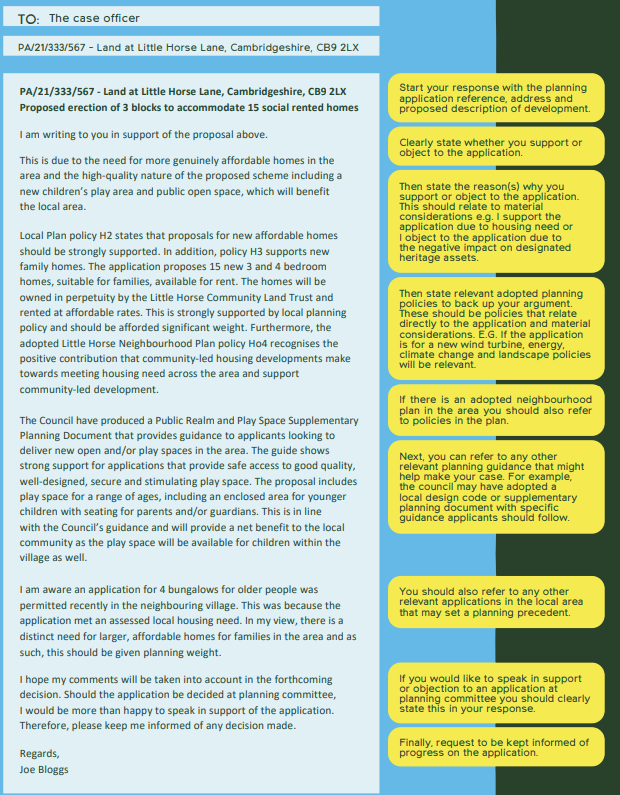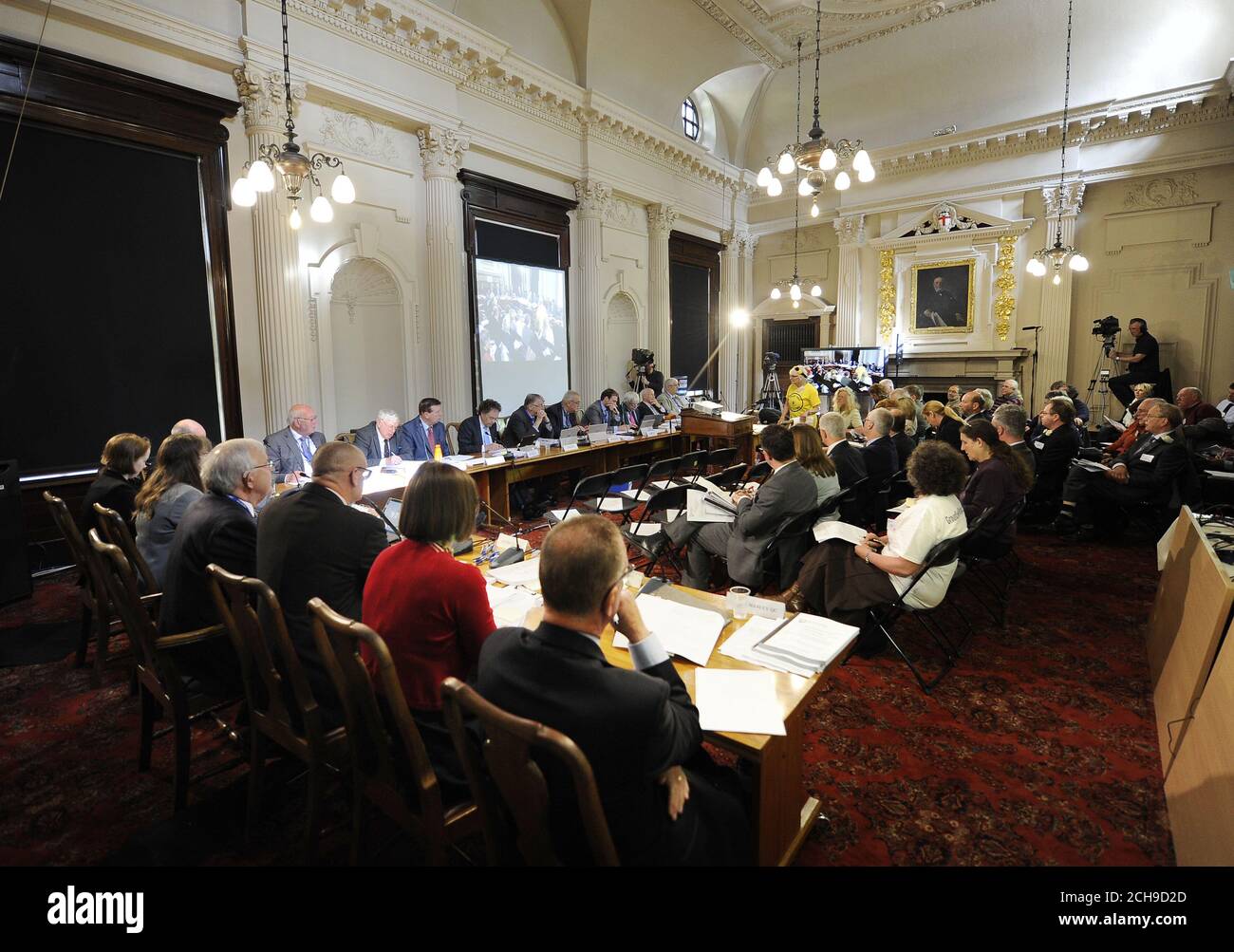
How to get involved in planning: CPRE's key steps
Now you have understood how the planning system works and the process through which most planning applications are determined, you are equipped to respond to applications in your local area.
We have set out some simple steps to follow below, which will help you provide a robust and well-evidenced response. Some of the steps may not be relevant to your application, for example, if the application is to be determined via delegated powers, you will not need to speak to the planning committee.
Step 1: The pre-application consultation process
It is mandatory to undertake pre-application consultation for certain projects including nationally significant infrastructure projects (NSIPs) and some major developments. Applicants must produce a Statement of Community Involvement or SCI that demonstrates how, when and what engagement took place with the local community before an application has been submitted.
Even if an SCI isn’t required, developers should engage with the local community before applying to understand concerns and build support.
Pre-application consultations vary. Developers might create a dedicated website with feedback tools or host in-person events at local community venues. Check local notice boards and the Council website for upcoming events. You can also contact your local CPRE group or other stakeholders who often follow new proposals closely.
Share your views before a planning application is submitted as developers can still make changes. Once a planning application has been submitted, it is very unlikely the proposal will change.
Post application submission
Once an application has been submitted the countdown to respond begins. The following steps should be followed once you have a submitted application in-front of you ready to review.
Checklist for pre-application engagement
Engage locally
Check with your local CPRE, local businesses, the Council and other local groups whether there are any planned pre-application engagement events.
Sign up for info
Sign-up for online webinars, in-person events and updates on the plans (if available).
Submit your views
Submit your views on the plans, with suggested changes if relevant to the developer. If you suggest changes, rather than objecting outright, your thoughts may be more likely to be considered.
Engage with the process
Join any local design review panels, or resident’s forums to provide joint feedback on the plans (if set up).
Top tips for finding out about new planning applications in your area
Stay connected
Stay connected with your local CPRE district or county group, who usually get weekly lists of planning applications.
Sign up for updates
Sign up for email alerts from your local authority. You can sign up to the Inspectorate’s email alert service to receive updates on the progress of an application.
Get in touch with your local planning authority
Ask your local planning authority to let you know about any application that is likely to be of interest to you.
Reach out to your local council
Contact your parish or town council, if you have one, who are legally entitled to receive copies of all planning applications in their area.
Look for local information
Scan local newspapers for information about significant developments proposed.
Check your local planning portal
Search the Council’s planning portal page on the website for recently submitted applications.
Look out for planning notices
Look out for notices pinned to gates, lampposts and walls on or near the boundary of sites where an application for planning permission has been made.
Look out for larger projects
Check the planning inspectorate website for a list of Nationally Significant Infrastructure Projects proposed in England (there is usually a weekly list of validated applications.)
Step 2: Review and assess the application
Have you heard about a planning application that has been submitted in your area and want to find out more about it?
Start by reviewing the validated application on your local planning authority’s website or at their offices. Use the planning reference or site address to find it.
The planning department uploads documents for review, including the application form. Major applications may include extensive documentation. Still, check that all validation criteria are met.
Checklist for step 2
Validate applications
Make sure that the applicant has met all the validation requirements by cross-checking the documents submitted. This includes making sure plans and drawings are drawn to scale and have a scale bar.
Read carefully
Look through all the documents carefully. There may be relevant information hidden within a supporting report.
Check that everything lines up
Check that the development description matches what’s proposed in the application form. Accuracy here is essential. Recent high-profile cases show developments can differ significantly from submitted plans. Careful scrutiny at this stage is especially valuable.
Ask for advice
Remember that case officers are there to help. Ask for advice if you are unsure about how to interpret an application, or what the wider effects of the proposal might be.
Step 3: Understand the planning context
As set out in Part 1 of this guide, planning applications are determined based on the following:
- The adopted development plan or Local Plan
- Material Considerations including national planning policy
- Planning precedent such as case law or relevant planning history
In order to decide whether you wish to respond to the development proposed you will need to understand the site-specific planning issues.
Planning context checklist
Check online maps
Check the policies map – this should be online and will set out any relevant planning designations on the site. For example, if the site is designated as a Site of Special Scientific Interest (SSSI) then it is likely to inappropriate for built development.
Check site allocation
Check whether the site has been allocated for a particular type of development. For example, if the LPA has allocated a site for housing, it will be difficult to object to a proposal for housing.
Review the development description
Review for description of development. Is the proposal in line with adopted planning policies?
Review the documents
Review the planning documentation. Are there any areas of concern? For example, is the site susceptible to flooding? If so, this would be a material consideration.
Delve into previous applications
Researching past planning applications for a site can reveal useful information. For example, if a proposal was rejected due to poor public transport, suggest ways to improve it when offering support.
Look for trends and assess impacts
Review recent planning applications in the wider area to spot development trends and assess their local impact. Consider how they might affect the area's economy, community, and natural environment.
Step 4: Choose whether to respond
Now it is time to decide what action you are going to take on the planning application.
You could choose to:
- Support the application because it will deliver public benefits for the local area, either now or in the long run.
- Support the application but ask for aspects of the proposed development to be reconsidered and changed to yield better outcomes for the local area.
- Take no action since the proposal’s overall effect would be neutral or of little relevance to your local place.
- Register an objection to the application due to harms arising, but suggest action that could be taken to address your objection, such as amending the proposal to avoid harms or attaching planning conditions or a planning obligation to mitigate or compensate for the harm identified.
- Request that the application be refused permission because of its negative impacts, that cannot be mitigated by planning conditions.
Step 5: Put your comments in writing
When you are completely clear on your position, and you would like to formally respond, the next step is to make your comments in writing to the planning authority before the appropriate deadline. You must do this if you want your comments on a planning application to be carefully considered.
The easiest way to respond is to submit your comments direct via the Council’s website. Alternatively, you could email the case officer or planning department or send a letter by post.
In order to help you craft your response we have set out an example below and right. We recommend following this structure:
| Start with the application reference | PA/21/333/567 |
| Then put the application address | Land at Little Horse Lane, Cambridgeshire, CB9 2LX |
| After that set out the description of development | Proposed erection of 3 blocks to accommodate 15 social rented homes |
| Then first set out your proposed response | I am writing to you in support of the proposal above. |
| And state your reason why | This is due to the need for more genuinely affordable homes in the area and the high-quality nature of the proposed scheme including a new children’s play area and public open space, which will benefit the local area. |
| Set out relevant adopted Local Plan policies, including any ‘Made’ Neighbourhood Plan policies relevant to the application | Local Plan policy H2 states that proposals for new affordable homes should be strongly supported. In addition, policy H3 supports new family homes. The application proposes 15 new 3 and 4 bedroom homes, suitable for families, available for rent. The homes will be owned in perpetuity by the Little Horse Community Land Trust and rented at affordable rates. This is strongly supported by local planning policy and should be afforded significant weight. Furthermore, the adopted Little Horse Neighbourhood Plan policy Ho4 recognises the positive contribution that community-led housing developments make towards meeting housing need across the area and support community-led development. |
| Next you can reference any relevant draft planning policy or supporting guidance such as a supplementary planning document | The Council have produced a Public Realm and Play Space Supplementary Planning Document that provides guidance to applicants looking to deliver new open and/or play spaces in the area. The guide shows strong support for applications that provide safe access to good quality, well-designed, secure and stimulating play space. The proposal includes play space for a range of ages, including an enclosed area for younger children with seating for parents and/or guardians. This is in line with the Council’s guidance and will provide a net benefit to the local community as the play space will be available for children within the village as well. |
| If there are other planning applications in the local area that might be relevant to the proposal you can make reference to them and the precedent they may set | I am aware an application for four bungalows for older people was permitted recently in the neighbouring village. This was because the application met an assessed local housing need. In my view, there is a distinct need for larger, affordable homes for families in the area and as such, this should be given planning weight. |
| Lastly, you should Sign off and state clearly that you would like to be kept informed of the application’s progress | I hope my comments will be taken into account in the forthcoming decision. Should the application be decided at planning committee, I would be more than happy to speak in support of the application. Therefore, please keep me informed of any decision made. |

Writing your letter or email - top tips
Refer to the development plan
List development plan policies that support your case and explain why. Recognise and respond to development plan policies that conflict with your views. Explain what other planning issues you believe should affect the decision.
Consider the public interest
Explain how the development affects the local community as a whole. Avoid focusing on issues such as land ownership, the effects of the proposal on the value of neighbouring property, or the personal circumstances of the applicant.
Be clear and courteous
Avoid personal issues and concentrate on the facts of the case . Separate out each point you want to make. Explain what you want to happen and, where appropriate, suggest conditions you want to see put on the application to improve the sustainability of the proposal. Try to be concise.
Get comments in on time
You usually have two weeks to respond to a planning application. Aim to submit comments before the deadline. If you need more time, send a short summary first and follow up with detailed comments later. Late responses might be considered, but there's no guarantee, especially if they risk delaying the decision.
Consider approaching the applicant
You could approach the applicant to let them know your views or to persuade them to improve the application, either before or after you write your letter/email.
Step 6: Gather support
Sharing your views with the planning authority is only the first step. Build support from the community and within the authority to strengthen your case. The more people who agree and speak up, the more likely your views will influence the decision.
Influencing Decision-Makers – Top Tips
Speak to the case officer
A few days after submitting comments, call the planning case officer to confirm receipt and ask how they’ll be considered. You can also request a meeting to explain your case. This may help strengthen weaker points or counter objections.
If the application goes to a planning committee, the officer writes a report recommending approval or refusal. Comments submitted on time may be summarised in this report.
You have the legal right to read the report at least five days before the meeting. Use this time to prepare to speak, understand what councillors will see, and alert local media if needed.
Some applications are decided by planning officers, not councillors. Authorities vary, so find out early who will decide and when. This helps shape your next steps.
Approach your local councillors
Send your objection letter to local councillors, especially those representing the affected ward. Contact them before the decision to ensure your views are heard. Find councillor details on the planning authority’s website or through council offices.
If the issue is best seen in person, suggest a site visit.
Councillors not on the planning committee can speak freely. Committee members must avoid bias but can comment on specific concerns.
Explain your support or objection clearly. Suggest conditions if permission is granted. Show both planning arguments and community backing; this often influences councillors more than officers.
Coordinate with parish councils, local groups (like CPRE, WI, or residents’ associations), businesses, your MP, and statutory consultees such as the Environment Agency. Petitions help, but individual letters carry more weight.
Approach planning committee members
Contact councillors who sit on the planning committee, as they make the final decision. Your ward councillor may attend and speak at your meeting, even if not on the committee. Focus on the views of the committee chair and avoid party politics. Councillors must decide based on planning grounds, not party lines.
Step 7: Register to speak at planning committee
(if relevant)
For applications heard at committee follow this step. If the application is proposed to be determined under delegated powers, skip this step.
Speaking at the committee meeting can make a real difference. Councillors often respond to strong local views.
Many councils allow public speaking for a few minutes. Contact your planning authority to check the rules. Confirm if you can speak, the meeting date, location, and your time slot; usually three minutes for both supporters and objectors.
Register at least a week in advance through the Council’s Democratic Services. Submit a written copy of your remarks and state your position.
Find out who else will speak to avoid repeating points. If that’s unclear, use the officer’s report to identify key responses and present shared views clearly.

Step 8: Review and understand the decision
After a decision is made, a notice is published online. The application will be either granted or refused. If granted, you may challenge the decision through judicial review. CPRE offers separate guidance on legal challenges to poor developments.
If refused, the developer can appeal. A planning inspector appointed by the government will reconsider the case. You can take part and repeat your points, but the appeal process is stricter and time-limited.
Granted applications often include conditions. These may require the applicant to submit more details before starting work. Every approval includes a ‘time limit’ for starting construction and a ‘compliance’ condition tied to approved plans. Compliance conditions don’t need formal approval, but ignoring them can lead to enforcement action.
Other conditions require formal approval or ‘discharge.’ These usually involve technical details beyond the original application and may cover topics such as:
Potential flood risk
Impacts on trees
Remediation of contaminated land
Installation of solar panels
Plans for external lighting
Installation of cycle parking
You will be able to view applications to discharge conditions on the same webpage as the original planning application. Applications to discharge conditions are usually determined by the case officer, who may or may not be the same officer who dealt with the original application.
In any case, it is always worth asking the duty planner if you are unsure about any information submitted or concerned that conditions have not been met.
Find out more
You can read or print the full version of this guide by downloading the PDF here, which also contains part 1: an introduction to the English planning system. If you want to read a shorter version of part 1, view the web version here.










